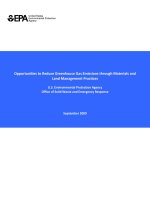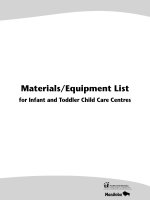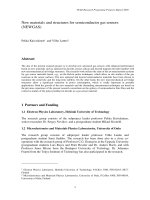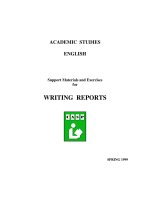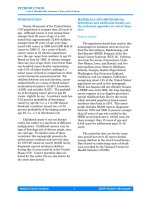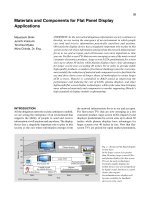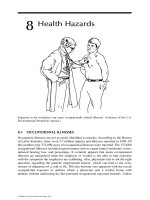Membrane materials and fabrication for gas separation
Bạn đang xem bản rút gọn của tài liệu. Xem và tải ngay bản đầy đủ của tài liệu tại đây (2.45 MB, 306 trang )
MEMBRANE MATERIALS AND FABRICATIONS FOR
GAS SEPARATION
TIN PEI SHI
NATIONAL UNIVERSITY OF SINGAPORE
2005
MEMBRANE MATERIALS AND FABRICATIONS FOR
GAS SEPARATION
TIN PEI SHI
(B. Eng. (Chemical) (Hons.), University Technology Malaysia)
A THESIS SUBMITTED
FOR THE DEGREE OF DOCTOR OF PHILOSOPHY
DEPARTMENT OF CHEMICAL AND BIOMOLECULAR
ENGINEERING
NATIONAL UNIVERSITY OF SINGAPORE
2005
i
ACKNOWLEGEMENTS
I wish to take this opportunity to express my sincere appreciation to all the
contributors whose cooperation and assistance were essential in helping me to
gradually acquire sharper tools toward the completion of my PhD study reported
herein:
First of all, I especially wish to record my deepest appreciation and thanks to my
immediate advisor, Professor Neal Chung Tai-Shung for his invaluable guidance,
advice, patience, constructive comments and challenges that helped me actualize and
sharpen my professional skills. I am also indebted to my co-advisors, Dr. Wang Rong
and Dr. Liu Ye for their keen efforts and consistent consultation throughout my
candidature.
I would like to gratefully acknowledge the research scholarship offered to me by the
National University of Singapore (NUS), which provided me a positive, conducive
and professional atmosphere for researching. Sincere thanks to Institute of Materials
Research and Engineering (IMRE) for the characterization instrument. I also wish to
express my recognition to Agency for Science, Technology and Research (A*Star)
and National Research Council Canada (NRC) for their financial support that enables
this work to be successfully completed.
I would like to convey my gratitude to Dr. Pramoda Kumari Pallathadka, Dr.
Dharmarajan Rajarathnam and Mr. Lim Poh Chong for their various assistances in
operating characterization instrument and equipment. I may also like to thank Dr.
ii
Anita J. Hill for her collaboration in conducting the PALS to characterize the carbon
membranes, as well as Dr. Liu Songlin for sharing his expertise in the mixed gas
permeation tests. My gratitude is extended to efforts of Mr. Ng Kim Poi, who
fabricated and contributed expert advice in equipment setup and machinery.
Of course, personal thanks go to all members of our research group, especially Dr.
Cao Chun and Mr. Xiao Youchang for many good times, discussion and sharing of
technical expertise. Special thanks to Ms. Chng Mei Lin for all her kindest
cooperation and handy help during my days in the laboratory. Also worth mentioning
are my friends that have been kind and helpful to me, which have made my study in
NUS enjoyable and memorable.
I must express my deepest love and hearties gratefulness to my family for their
endless support, enduring patience and positive encouragement that brighten up every
phase of my life. I can never sufficiently thank or acknowledge them for their
unwavering and unconditional love.
Last but not least, acknowledgements are due to all those who have assisted me in any
way throughout the period of my PhD study, for both directly and indirectly continued
assistance and support that I received.
iii
TABLE OF CONTENTS
Page
ACKNOWLEDGEMENT…………………………………………………………… i
TABLEOF CONTENTS…………………………………………………………… iii
SUMMARY………………………………………………………………………… x
NOMENCLATURE…………………………………………………………………xiii
LIST OF TABLES………………………………………………………………… xix
LIST OF FIGURES…………………………………………………………………xxii
CHAPTER 1 INTRODUCTION AND PERSPECTIVE OF GAS SEPARATION
MEMBRANE…… ………………………………………………….1
1.1 Membrane-Based Gas Separations…………………………………………….4
1.1.1 Scientific Milestones………………………………………………… 5
1.1.2 Advantages of Membrane Gas Separation…………………………….9
1.2 Industrial Applications of Membrane Gas Separation……………………….10
1.3 Engineering Principles for Membrane Gas Separation………………………14
1.3.1 Membrane Materials Selection…………………………………… 15
1.3.1.1 Organic (Polymeric) Materials………………………….….17
1.3.1.2 Inorganic Materials…………………………………………19
1.3.1.3 Mixed Matrix Membranes………………………………….20
1.3.2 Membrane Fabrication and Modification…………………………….22
1.3.3 Membrane Characterization and Evaluation…………………………24
1.3.4 Membrane Modules and Design Considerations…………………… 25
1.4 Gas Transport Mechanisms of Membrane Separation……………………….29
1.4.1 Poiseuille Flow……………………………………………………….31
iv
1.4.2 Knudsen Diffusion………………………………………………… 31
1.4.3 Molecular Sieving……………………………………………………32
1.4.4 Solution-Diffusion……………………………………………………33
1.5 Research Objective and Organization of Dissertation……………………….34
CHAPTER 2 POLYMERIC MEMBRANES FOR GAS SEPARATION………38
2.1 Principles of Membrane Gas Separation…………………………………… 38
2.2 Theory of Gas Transport in Nonporous Glassy Polymeric Membranes…… 44
2.2.1 Polymers Free Volume and Occupied Volume………………………44
2.2.2 Dual-Mode Sorption Model ……………………………………… 45
2.2.3 Dual-Mode Model for Permeation ………………………………… 48
2.2.4 Effect of Upstream Pressure on Gas Sorption and Permeation………50
2.2.5 Effect of Temperature on the Gas Transport Properties…………… 52
2.3 Membrane Materials for Gas Separation-Polyimides……………………… 54
2.4 Advanced Modification of Polymeric Membranes………………………… 58
CHAPTER 3 CARBON MOLECULAR SIEVE MEMBRANES FOR GAS
SEPARATION………………………………………………………63
3.1 Introduction…………………………………………………… 63
3.2 Fabrication of Carbon Molecular Sieve Membranes……………………… 64
3.2.1 Selection of Polymeric Precursors and Membranes Preparation…….65
3.2.2 Pyrolysis of Polymeric Precursors………………………………… 67
3.2.3 Modification of Carbon Membranes…………………………………73
3.2.3.1 Pretreatment……………………………………………… 73
3.2.3.2 Post-treatment…………………………………………… 76
v
3.2.4 Configurations of Carbon Membranes……………………………….79
3.3 Microstructure of Carbon Membranes……………………………………….82
3.4 Mechanisms of Gas Transport in Carbon Membranes……………………….85
CHAPTER 4 MATERIALS AND EXPERIMENTAL PROCEDURES……… 89
4.1 Materials…………………………………………………………………… 89
4.1.1 Polymers…………………………………………………………… 89
4.1.2 Molecular Sieves…………………………………………………… 91
4.2 Preparation of Polymeric Membranes……………………………………… 92
4.2.1. Polymeric Dense Film Formation……………………………………92
4.2.2 Chemical Cross-linking Modification……………………………… 92
4.3 Fabrication of Carbon Membranes………………………………………… 93
4.3.1 Polymeric Dense Film Formation…
.…………………………………93
4.3.2 Pretreatment………………………………………………………… 93
4.3.2.1 Chemical Cross-linking Modification…………………… 93
4.3.2.2 Nonsolvent Pretreatment………………………………… 94
4.3.3 Pyrolysis Process…………………………………………………… 94
4.4 Fabrication of Carbon-Zeolite Composite Membranes………………………96
4.4.1 Preparation of Polymer-zeolite Mixed Matrix Membranes (MMMs) 96
4.4.2 Pyrolysis Process…………………………………………………… 96
4.5 Characterization of Physical Properties…………………………………… 97
4.5.1 Measurement of Gel Content……………………………………… 97
4.5.2 Fourier Transform Infrared Spectrometer (FTIR)……………………98
4.5.3 Differential Scanning Calorimetry (DSC)……………………………98
4.5.4 Modulated Differential Scanning Calorimetry (MDSC)…………… 98
vi
4.5.5 Dynamic Mechanical Analysis (DMA)………………………………99
4.5.6 Thermomechanical Analysis (TMA)…………………………………99
4.5.7 Elemental Analysis………………………………………………….100
4.5.8 Measurement of Density……………………………………………100
4.5.9 Thermogravimetric Analysis (TGA)……………………………… 101
4.5.10 TGA-FTIR………………………………………………………… 101
4.5.11 Wide-angle X-ray Diffraction (WAXD)……………………………102
4.5.12 Surface Area and Pore Size Analyzer………………………………102
4.5.13 Positron Annihilation Lifetime Spectroscopy (PALS)…………… 103
4.5.14 Scanning Electron Microscope (SEM)…………………………… 103
4.6 Characterization of Gas Transport Properties………………………………104
4.6.1 Constant Volume-Variable Pressure Method……………………….104
4.6.2 Pure Gas Permeation Tests………………………………………….106
4.6.3 Mixed Gas Permeation Tests……………………………………… 109
4.6.4 Pure Gas Sorption Tests…………………………………………….113
CHAPTER 5 CHEMICAL CROSS-LINKING MODIFICATION OF
POLYIMIDE MEMBRANES FOR GAS SEPARATION…… 115
5.1 Introduction……………………………………………………………… 115
5.2 Results and Discussion…………………………………………………… 118
5.2.1 Characterization of Cross-Linked Matrimid Membranes………… 118
5.2.2
Mechanisms of Chemical Cross-linking Reaction…………………… 121
5.2.3 Pure Gas Transport Properties of Matrimid®5218…………………125
5.2.4 Effect of Cross-Linking on Plasticization Phenomenon……………134
5.2.5 Permeation Transport of Mixed Gases…………………………… 136
vii
5.3 Conclusion………………………………………………………………… 139
CHAPTER 6 SEPARATION OF CO
2
/CH
4
THROUGH CARBON
MOLECULAR SIEVE MEMBRANES DERIVED FROM
POLYIMIDES…………………………………………………… 141
6.1 Introduction…………………………………………………… 141
6.2 Results and Discussion…………………………………………………… 144
6.2.1 Characterization of Carbon Membranes…………………………….144
6.2.2 CO
2
/CH
4
Permeation Performance of P84-derived Carbon
Membranes………………………………………………………….151
6.2.3 A Comparison of Gas Separation Performance between
P84-derived CMSMs and Other Commercially Available
Polyimides-derived CMSMs……………………………………… 153
6.2.4 Separation of CO
2
/CH
4
Binary Mixture……………………………158
6.3 Conclusion………………………………………………………………….160
CHAPTER 7 NOVEL APPROACHES TO FABRICATE CARBON
MOLECULAR SIEVE MEMBRANES BASED ON
CHEMICAL MODIFIED AND NONSOLVENT-TREATED
POLYMIDES………………………………………………………162
7.1 Introduction…………………………………………………………………162
7.2 Pretreatment I: Chemical Cross-Linking Modification…………………… 166
7.2.1 Results and Discussion…………………………………………… 167
7.2.1.1 Characterization of Carbon Membranes………………… 167
7.2.1.2 Effects of Pyrolysis on Pure Gas Permeation Properties…173
viii
7.2.1.3 Effects of Cross-linking Degree on the Gas Permeation
Properties of CMSMs Derived from Matrimid Precursor 176
7.2.1.4 Pure Gas Permeation Properties of CMSMs Based
on the Methanol Pretreated Polyimides………………… 177
7.3 Pretreatment II: Nonsolvent Pretreatment………………………………… 181
7.3.1 Results and Discussion…………………………………………… 181
7.3.2.1 Thermal Behavior of Nonsolvent Treated
Matrimid and P84 Precursors…………………………… 181
7.3.2.2 Characterization of Carbon Membranes………………… 182
7.3.2.3 Effects of Nonsolvent Pretreatment on the
Pure Gas Permeation Properties of Resultant
Carbon Membranes……………………………………….190
7.3.2.4 Selective Transport in Carbon Membranes……………….194
7.4 Conclusion………………………………………………………………… 199
CHAPTER 8 CARBON-ZEOLITE COMPOSITE MEMBRANES FOR
GAS SEPARATION……………………………………………….202
8.1 Introduction…………………………………………………………………202
8.2 Results and Discussion…………………………………………………… 206
8.2.1 Characterization of Polymer-Zeolite Mixed Matrix
Membranes (MMMs)……………………………………………….206
8.2.2 Characterization of Carbon-Zeolite Composite Membranes……… 208
8.2.3 Pure Gas Permeation Properties of Carbon-Zeolite
Composite Membranes…………………………………………… 211
8.3 Conclusion………………………………………………………………… 215
ix
CHAPTER 9 CONCLUSIONS AND RECOMMENDATIONS……………….217
9.1 Conclusions…………………………………………………………………217
9.1.1 Chemical Cross-linking Modification of Polyimide
Membranes for Gas Separation…………………………………… 218
9.1.2 Separation of CO
2
/CH
4
through Carbon Molecular
Sieve Membranes (CMSMs) Derived from Polyimides……………219
9.1.3 Novel Approaches to Fabricate Carbon Molecular
Sieve Membranes Based on Chemical Modified and
Nonsolvent-Treated Polyimides…………………………………….220
9.1.4 Carbon-Zeolite Composite Membranes for Gas Separation……… 222
9.2 Recommendations for Future Work……………………………………… 222
9.2.1 Chemical Cross-linking Modification of Polyimide Membranes 223
9.2.2 Fabrication of Carbon Molecular Sieve Membranes……………….224
9.2.3 Fabrication of Carbon-Zeolite Composite Membranes…………… 226
REFERENCES…………………………………………………………………….228
APPENDICES
Appendix A Derivations of the Average Diffusion Coefficient and the
Effective Diffusion Coefficient Base on the Definition of
Permeability…………………………………………………………266
Appendix B Calculations of the Volume of Downstream Compartments
in a Gas Permeation Cell……………………………………………268
Appendix C Calculations of the Fractional of Free Volume (FFV)…………… 269
Appendix D Calculations of Solubility Parameter (
δ
sp
)…………………………275
x
SUMMARY
The purpose of this work is to evaluate the use of commercially available polyimides
as the precursor to prepare the high performance membranes for gas separation. A
comprehensive research study, which covers the fabrication and characterization of
three types of membranes, particularly cross-linked polymeric membrane, carbon
molecular sieve membrane (CMSM) and carbon-zeolite composite membrane, is
presented. Various instruments were employed to screen the physical properties and
gas separation performance of these membranes. Emphases were put on the
separation of CO
2
/CH
4
, O
2
/N
2
and He/N
2
because of their high market impact.
Firstly, the effectiveness of chemical cross-linking modification in improving the gas
separation capability of polyimide membranes was investigated. An extremely simple
room-temperature chemical cross-linking modification was performed on Matrimid®
5218. The influence of cross-linking modification on thermal and gas transport
properties of Matrimid membranes were studied. The gas permeability of cross-
linked membranes decreased with immersion time (The time for membranes being
immersed in cross-linking reagent) after achieved the maximum value at 1-day
immersion time. On the other hand, the ideal selectivity for O
2
/N
2
, CO
2
/CH
4
and
CO
2
/N
2
remain almost constant with cross-linking reaction, except for He/N
2
, where
the ideal selectivity increased with cross-linking density. Experimental results
showed that the proposed cross-linking modification was capable to enhance the anti-
plasticization characteristics of polymeric membranes (This work was published in
the J. Membr. Sci., 2003, 225, 77-90).
xi
Secondly, carbon molecular sieve membranes were prepared through pyrolysis of
commercially available polyimides with excellent intrinsic separation properties.
WAXD, density measurement and TGA-FTIR were performed to characterize the
morphology of carbon membranes and the degradation of precursor during pyrolysis.
The permeation properties of single and equimolar binary gas mixture through carbon
membranes were measured and analyzed. A comparison of permeation properties
among carbon membranes derived from 4 commercially available polyimides showed
that the P84 carbon membranes exhibited the highest separation efficiency for
CO
2
/CH
4
separation. The mixed gas permeation data confirmed the underestimation
of separation efficiency by pure gas permeation measurement (This work was
published in the Carbon, 2004, 42, 3123-3131).
One of the most significant contributions of this work is development of two novel
pretreatment approaches in enhancing the separation capability of CMSMs. These
two approaches were chemical cross-linking modification and nonsolvent
pretreatment. The permeation properties of carbon membranes derived from cross-
linked polyimide precursors were characterized as a function of cross-linking density.
The improved separation efficiency of CMSM was achieved at low degree of cross-
linking, as compared to untreated CMSM. Besides, an extensive study was conducted
to investigate the effect of nonsolvent (methanol, ethanol, propanol and butanol)
pretreatment on the separation properties of resultant CMSMs. Various
characterization methods verified that the nonsolvent pretreatment appears to be an
effectual approach to produce highly selective CMSMs (This work was published in
the (1) Macromol. Rapid Commun., 2004, 25, 1427-1250; (2) Microporous and
xii
Mesoporous Materials, 2004, 73, 151-160; and (3) Ind. Eng. Chem. Res., 2004, 43,
6476-6483. A US Provisional Patent Application has been filed on 26 Feb 2004).
Lastly, a new membrane material, carbon-zeolite composite membrane with excellent
separation performance is introduced. This heterogeneous or hybrid membranes
comprising of zeolite entities dispersed in carbon matrix were prepared through the
pyrolysis of zeolite-filled polymeric mixed matrix membranes. The morphology and
pure gas permeation properties of carbon-zeolite composite membranes were
characterized. The experimental results revealed that the improved ideal selectivity
was obtained with the correct selection of polymer/zeolite pair. The composite
membranes possessed good separation properties with combining the advantages of
carbon membranes and zeolite materials (This work was published in the Carbon,
2005, 43, 2025-2027. A US Provisional Patent Application has been filed on 22 Oct
2004).
xiii
NOMENCLATURE
A Effective are of the membrane (cm
2
)
b Langmuir affinity constant (1/atm)
C
Local penetrant concentration in the membrane
(cm
3
(STP)/cm
3
(polymer))
C
D
Henry sorption concentration (cm
3
(STP)/cm
3
(polymer))
C
i
Local penetrant concentration of species i in the membrane
(cm
3
(STP)/cm
3
(polymer))
C
H
Langmuir sorption concentration (cm
3
(STP)/cm
3
(polymer))
C
H
’ Langmuir capacity constant (cm
3
(STP)/cm
3
(polymer))
C
1
Local penetrant concentration at downstream side
(cm
3
(STP)/cm
3
(polymer))
C
2
Local penetrant concentration at upstream side
(cm
3
(STP)/cm
3
(polymer))
∆
C Concentration difference between the upstream and the downstream of
a membrane
D Diffusion coefficient (cm
2
/s)
D
app
Apparent diffusion coefficient, (cm
2
/s)
D
avg
Average diffusion coefficient, (cm
2
/s)
D
A
Diffusion coefficient of component A (cm
2
/s)
D
B
Diffusion coefficient of component B (cm
2
/s)
D
D Henry’s diffusion coefficient (cm
2
/s)
H
D Langmuir’s diffusion coefficient (cm
2
/s)
k
D Knudsen diffusion coefficient (m
2
/s)
xiv
0
D
Pre-exponential factor of activation energy for diffusion (cm
2
/s)
d Average d-spacing (Å)
gas
d Diameter of gas molecule (m)
d
p
Pore size (m)
dp/dt Change of pressure with time in the downstream chamber of the
permeation cell (mmHg/s)
coh
E Structural component for the overall solubility parameter (cal/mol)
D
E
Activation energy of diffusion (kJ/mol)
P
E Activation energy of permeation (kJ/mol)
F
H
D
D
D
S
H∆
Enthalpy of solution (kJ/mol)
J Permeation flux (cm
3
/cm
2
-s)
J
D
Henry’s diffusional flux (cm
3
/cm
2
-s)
J
H
Langmuir’s diffusional flux (cm
3
/cm
2
-s)
K
'
H
D
Cb
k
k
D
Henry’s dissolution constant (cm
3
(STP)/cm
3
(polymer)-atm)
L Membrane thickness (cm)
M
W
Molecular weight (g/mole)
n Integral number (1, 2, 3…)
P Gas Permeability coefficient of a membrane (1 Barrer = 1 x 10
-10
cm
3
(STP)-cm/cm
2
-s-cm Hg)
P
A
Permeability coefficient of a membrane to gas A (1 Barrer = 1 x 10
-10
cm
3
(STP)-cm/cm
2
-s-cm Hg)
xv
P
B
Permeability coefficient of a membrane to gas B (1 Barrer = 1 x 10
-10
cm
3
(STP)-cm/cm
2
-s-cm Hg)
0
P
Pre-exponential factor for the activation energies of permeation
(1 Barrer = 1 x 10
-10
cm
3
(STP)-cm/cm
2
-s-cm Hg)
p Penetrant Pressure (cmHg)
p
1
Downstream pressure of the penetrant (cmHg)
p
2
Upstream pressure of the penetrant (cmHg)
∆
p Pressure difference between the upstream and the downstream of a
membrane (cmHg)
Q Volumetric flow rate of gas at standard temperature and
pressure (cm
3
(STP)/s)
R Universal gas constant
r Pore radius (m)
S Solubility coefficient (cm
3
(STP)/cm
3
(polymer)-cmHg)
S
app
Apparent solubility coefficient (cm
3
(STP)/cm
3
(polymer)-cmHg)
S
A
Solubility coefficient of component A (cm
3
(STP)/cm
3
(polymer)-cmHg)
S
B
Solubility coefficient of component B (cm
3
(STP)/cm
3
(polymer)-cmHg)
S
0
Pre-exponential factor for the apparent enthalpy of solution
(cm
3
(STP)/cm
3
(polymer)-cmHg)
δ
sp
Solubility parameter
((cal/cm
3
)
1/2
)
∆
δ
sp
Difference of solubility parameter
((cal/cm
3
)
1/2
)
T Absolute temperature of measurement (K)
T
d
Degradation temperature of polymer which corresponding to 5%
weight loss (
°C)
T
g
Glass transition temperature (°C)
xvi
t Permeation time (s)
V Volume of the downstream chamber (cm
3
),
V
s
Specific volume (cm
3
/g)
V
f
Unrelaxed free volume in polymer (cm
3
/g)
i
m
V
Molar volume of component i (cm
3
/mol).
V
o
Occupied/equilibrium volume (cm
3
/g)
V
p
Volume of polymer sample volume (cm
3
)
w
V Van der Waals volume (cm
3
/g)
v Average molecular velocity (m/s)
W
0
Original weight of cross-linked films (g)
W
1
Insoluble fraction weight of cross-linked films after extraction (g)
W
p
Weight of polymer (g)
W
sp
Weight of sample pan (g)
w
o
Membrane weight in air (g)
w
1
Membrane weight in solvent (g)
x Distance between the upstream and the downstream of a
membrane (cm)
x
A
Upstream mole fractions of component A
x
B
Upstream mole fractions of component B
2
CO
x CO
2
molar fraction in the feed gas
x
i
Upstream mole fractions of component i
y
A
Downstream mole fractions of component A
y
B
Downstream mole fractions of component B
2
CO
y CO
2
molar fraction in the permeate gas
xvii
y
i
Downstream mole fractions of component i
/
A
B
α
Separation factor of a gas pair
/
*
A
B
α
Ideal selectivity of a gas pair
/
D
A
B
α
Ideal selectivity of a gas pair for diffusivity
/
S
A
B
α
Ideal selectivity of a gas pair for solubility
κ
Boltzmann constant (J/K)
λ X-ray wavelength (Å)
'
λ
Mean free path of a gas (Å)
ρ
Density (g/cm
3
)
membrane
ρ
Density of membrane (g/cm
3
)
liquid
ρ
Density of solvent (g/cm
3
)
σ
eff
Effective molecular diameter (Å)
σ
k
Kinetic molecular diameter (Å)
σ
LJ
Lennard-Jones collision diameter (Å)
θ
Time lag (s)
ϑ
Diffraction angle (°)
τ
1
Positron lifetimes (s)
φ
Volume fractions
xviii
Abbreviations
2,6-DAT 2,6-diamino toluene
6FDA 2,2’-bis(3,4’-dicarboxyphenyl) hexafluoropropane dianhydride
ATR Attenuated Total Reflection
BTDA 3,3’4,4’-benzophenone tetracarboxylic dianhydride
CTE Coefficient of Thermal Expansion
DAPI diamino-phenylindane
DMA Dynamic Mechanical Analysis
DSC Differential Scanning Calorimetry
Durene 2,3,5,6-tetramethyl-1,4-phenylenediamine
FFV Fractional of Free Volume
FTIR Fourier Transform Infrared Spectroscopy
MDI Methylene dianiline
MDSC Modulated Differential Scanning Calorimetry
oPs Ortho-positronium
PALS Positron Annihilation Lifetime Spectroscopy
SEM Scanning Electron Microscope
TDI Methylphenylene-diamine
TGA Thermogravimetric Analysis
TGA-FTIR Thermogravimetric Analysis-Fourier Transform Infrared Spectroscopy
TMA Thermomechanical Analysis
WAXD Wide-angle X-ray Diffraction
xix
LIST OF TABLES
Table 1.1 Development of Membrane Processes Market……………………… 2
Table 1.2 Future Market of Membrane Gas Separation………………………….3
Table 1.3 Scientific Developments of Membrane Gas Transport……………… 7
Table 1.4 Industrial Applications of Gas Separation Membranes………………11
Table 1.5 Materials for Gas Separation Membranes……………………………16
Table 1.6 Qualitative Comparisons of Various Membrane Modules……… …29
Table 2.1 List of Companies Active in Patenting……………………………….56
Table 2.2 Membrane Modification Methods……………………………………59
Table 4.1 Chemical structures and properties of Matrimid® 5218 and P84……90
Table 4.2 Main Characteristics of Zeolites…………………………………… 91
Table 5.1 Gas Separation Properties of Untreated and Cross-Linked
Matrimid Dense Films………………………………………………126
Table 5.2 Gas Diffusion Coefficient and Solubility Coefficients of
Cross-Linked Polyimides………………………………………… 130
Table 5.3 Molecule Diameters of Gases Tested in This Study……………… 131
Table 5.4 Comparison of Transport Performance for Matrimid Membranes
between the Mixed gas and Pure Gas Measurements………………138
Table 6.1 Elemental Analysis of P84 and Matrimid Precursors and Their
Pyrolyzed Membranes………………………………………………145
Table 6.2 Density of P84-derived Carbon Membranes……………………… 146
Table 6.3 Gas Separation Properties of P84 Precursor and Derived
Carbon Membranes…………………………………………………153
xx
Table 6.4 Chemical Structures and Properties of Commercially Available
Polyimides………………………………………………………… 154
Table 6.5 Comparison between the Gas Permeation Properties of P84-
and Matrimid-Derived CMSMs…………………………………….155
Table 6.6 Comparison of Transport Performances for P84-derived Carbon
Membranes between Mixed Gas and Pure Gas Measurements…….159
Table 7.1 Elemental Analysis of Matrimid Precursor and Pyrolyzed
Membranes………………………………………………………….168
Table 7.2 Density of CMSMs Derived from Untreated and Cross-linked
Matrimid…………………………………………………………….169
Table 7.3 Gas Separation Properties of Matrimid Precursor and Carbon
Membranes………………………………………………………….174
Table 7.4 Gas Separation Properties of CMSMs Derived from
Methanol-treated Matrimid…………………………………….… 178
Table 7.5 Glass Transition Temperatures (
T
g
) of Matrimid and P84
Membranes………………………………………………………….182
Table 7.6 Chemical Structures and Properties of Nonsolvents Used for
Pretreatment…………………………………………………………185
Table 7.7 Solubility Parameter of Polyimides and Nonsolvents………………186
Table 7.8 Positron Annihilation Lifetime Spectroscopy Parameters for
Selected CMSMs……………………………………………………189
Table 7.9 Gas Permeation Properties of Carbon Membranes Derived from
Nonsolvent-treated Matrimid……………………………………….191
Table 7.10 Gas Permeation Properties of Carbon Membranes Derived from
Nonsolvent-treated P84………………………………………….….192
xxi
Table 7.11 Gas Transport Properties of Carbon Membranes Derived from
Methanol- and Ethanol-treated Matrimid at Various Immersion
Time…………………………………………………………………193
Table 7.12 Gas Diffusion and Sorption Coefficients of CMSMs Derived
from Matrimid………………………………… ………………… 196
Table 7.13 Sorption and Diffusion Selectivities of CMSMs Derived from
Matrimid…………………………………………………………….197
Table 8.1 Gas Separation Properties of Matrimid Precursor and
Matrimid-Zeolite Mixed Matrix Membranes……………………….211
Table 8.2 Gas Separation Properties of Carbon-Zeolite Composite
Membranes………………………………………………………….212
xxii
LIST OF FIGURES
Figure 1.1 Schematic diagram of gas separation process by a membrane……… 5
Figure 1.2 Milestones in the development of membrane gas separations……… 9
Figure 1.3 Schematic of the specific volume of polymer as a function of
temperature………………………………………………………… 17
Figure 1.4 Trade-off line curve of oxygen permeability and oxygen/nitrogen
selectivity…………………………………………………………… 19
Figure 1.5 Schematic of a mixed matrix membrane…….……………………….21
Figure 1.6 Typical membrane morphology………….………………………… 24
Figure 1.7 Schematic drawing of a plate-and-frame module…………………….26
Figure 1.8 Spiral-wound elements and assembly……………………………… 27
Figure 1.9 Hollow fiber separator assembly…………………………………… 28
Figure 1.10 Schematic presentation of main mechanisms of membrane-based
gas separation……………………………………………………… 30
Figure 2.1 Gas membrane separations………………………………………… 38
Figure 2.2 Aromatic characteristics in polyimides contribute to their
thermo-oxidative stability…………………………………………….57
Figure 3.1 Carbon membrane fabrication process……………………………….65
Figure 3.2 Conceptual model for “pore” structure evolution and reorganization
in PFA-derived CMSM………………………………………………70
Figure 3.3 Configurations of carbon membranes……………………………… 80
Figure 3.4 Structure of turbostratic carbon………………………………………83
Figure 3.5 Idealized structure of a pore in a carbon material……………………84
Figure 4.1 Chemical structure of
p-xylenediamine…………………………… 92
xxiii
Figure 4.2 Steps involved in pyrolysis process at final temperature of
(a) 550 °C, (b) 650 °C and (c) 800 °C……………………………… 95
Figure 4.3 Schematic diagram of a gas permeation cell……………………… 105
Figure 4.4 Pressure versus time plot (transient and steady state permeation)….108
Figure 4.5 Schematic diagram of dense membrane mixed gas permeation
test apparatus……………………………………………………… 112
Figure 4.6 Schematic diagram of the microbalance sorption cell…… ……….113
Figure 5.1 MDSC thermograph of original and modified Matrimid
membranes………………………………………………………… 119
Figure 5.2 DMA results for original and modified Matrimid membranes.…….120
Figure 5.3 Plot of TMA for original and modified Matrimid membranes…… 121
Figure 5.4 A comparison of FTIR spectra for Matrimid: (a) Original sample;
(b) and (c) cross-linked sample obtained by immersing in
cross-linking reagent for 32 days and 61 days, respectively……… 122
Figure 5.5 Chemical cross-linking modification by
p-xylenediamine
methanol reagent solution………………………………………… 123
Figure 5.6 Mechanism of chemical cross-linking modification and the
possible cross-linking structure…………………………………… 124
Figure 5.7 Influence of immersion time on the pure gas permeabilities of
Matrimid…………………………………………………………….127
Figure 5.8 Gas separation properties of Matrimid dense films in methanol……127
Figure 5.9 Influence of immersion time on the decreasing order of gas
permeabilities……………………………………………………….129
